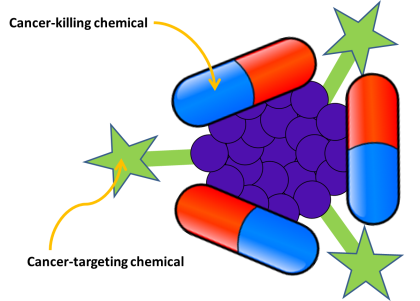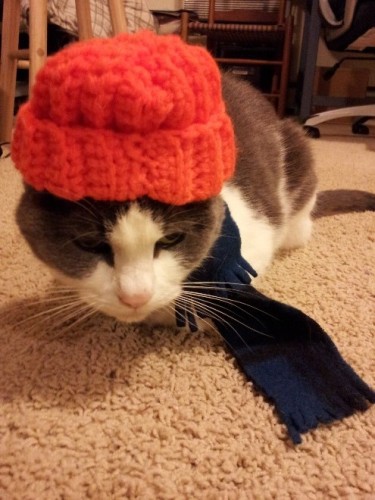I present to you my cat, Graboid. She has nanoparticles coursing through her veins, and those nanoparticles may save her life.
Grabby is 14 years old. She was not featured at the Internet Cat Video Film Festival at the Minnesota State Fair, but I still think she’s pretty great. Unfortunately, Grabby has oral squamous cell carcinoma, which is a common but completely incurable and very aggressive cancer of the jaw.
When my wife and I were weighing the options for our cat, we found out that generally the treatments for oral cancer in cats are palliative (designed to relieve pain, but not fix the underlying problem) and ineffective. However, Grabby was eligible for a nanoparticle-based clinical trial at the University of Minnesota Veterinary Medical Center run by Dr. Antonella Borgatti. Since we like science, and Grabby hasn’t expressed any particular opposition to science, we signed her up for it.
There are many ways in which nanoparticles can be applied to medical issues. Silver nanoparticles have an innate ability to act as antibiotic agents, but as more research is done it is apparent that we have only scratched the surface of this potential. When used in tandem with traditional antibiotics, nanoparticles have decreased the survival rate of pathogenic bacteria (bad for bacteria, good for us). This is especially important when applied to new strains of antibiotic-resistant bacteria, which have recently gained notoriety for being very difficult to eliminate.
Nanoparticles are also used to increase the ability of medical diagnostic tools to detect problems in the body. Since they can gather in areas of importance in relation to diseases, nanoparticles are used to provide extra contrast when trying to locate things that do not appear that different from the surrounding tissues using diagnostics such as MRI.
Another way scientists use nanoparticles is as delivery vehicles for drugs that are otherwise challenging to deliver to a patient. They can be designed to house a drug or other therapy agent that needs to be released in close proximity with the target organ or tissue. Nanoparticles tend to gather in certain areas based on their characteristics. For example, nanoparticles can be coated with things that bind to specific sites present on diseased tissues, which causes them to localize in that area. Many types of nanoparticle will gather in tumors because tumors have a poor drainage system, so they cannot eliminate nanoparticles as efficiently as healthy tissue, making this a promising area of research for cancer treatment.

The particular clinical trial that Graboid is in uses nanoparticles to attack a protein called CK2. This protein allows cancer cells to grow indefinitely, instead of undergoing the process of programmed cell death like healthy tissue. This treatment works via a technique known as gene therapy, where the nanoparticle kills cells by delivering DNA that prohibits cells from manufacturing CK2. The idea is that the nanoparticles can prevent the gene therapy from destroying normal tissue, because CK2 is an important protein for the function of healthy cells. The scientists who developed this treatment are using the nanoparticle as a delivery agent to target cancer cells, and when the nanoparticles reach the cancer cells the gene therapy disrupts the cancer cells’ ability to manufacture CK2, with the goal of killing the cancer cells. This therapy has been shown to work in mice and rats, and if it works in cats and dogs, there’s a chance that the scientists will be able to apply this treatment to humans.
Since we like science and we like our cat, this summer we’ve been bringing Grabby to the U of M Small Animal Hospital twice a week, where she receives an injection of nanoparticles into her leg veins. She had a tumor biopsy before the trial and will have one again after the trial is finished. The clinicians have declined our suggestion to give her authorship credits on publications stemming from the trial, although if I find out that she’s been making uncredited intellectual contributions to the project (she’s a very vocal cat), I’ll be hopping mad. Currently, she has received 75% of her total nanoparticle injections, and she still eats and meows and sits on any laptop accessible to her. She hasn’t developed any X-Men-like superpowers, but we are still hopeful on that front.




Way to promote the development of nanoparticles in curing cancer Grabby!!
Great post. Keep up the good work, sustainable-nano. I really enjoy reading about the research y’all are doing.
Thanks for the kind words and thanks for stopping by! 🙂
Stay strong, Grabby! Great post, Ben.
can this work in humans?
Ideally, yes. It would be applied to humans. If tests like these prove that the concept is sound, it could be used to treat cancer in humans with some modifications.
so sweet! i hope it all works out for your cat!
me too!